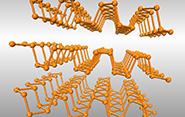In Black Phosphorus, Engineers Look for the Future of Electronics and Optoelectronics in this New 2D Material

Yale Engineers and an IBM Scientist have identified black phosphorus, the most stable phosphorus allotrope traditionally considered for battery anode applications, as a novel 2D material that exhibits high carrier mobility and extraordinary optical responses, for constructing future thin-film electronics and infrared imagers. Moreover, the researchers revealed its in-plane anisotropic properties, which may find special applications in electronics and optics.
“Black phosphorus is in many situations an ideal combination of the high mobility (for high speed) and the desirable bandgap (for transistors with sufficient on-off current ratio to minimize power consumption and perform logic operations). In addition, its moderate bandgap, which is tunable over a wide range with layer number and strain (0.3-2.0 electron-volt), allow for the realization of various mid- and near-infrared photonic devices such as photodetectors and modulators,” says Fengnian Xia, assistant professor of electrical engineering and lead author of the research published on July 21 in Nature Communications. Other authors include Dr. Han Wang from IBM (now an assistant professor in Ming Hsieh Department of Electrical Engineering, University of Southern California) and Yichen Jia from Yale University.
 Black phosphorus’ combined high mobility and a finite bandgap are notable because these two properties are often mutually exclusive in other 2D materials. Semiconducting 2D materials such as molybdenum disulfide (MoS2), for example, has a sizable bandgap. However, it has a low mobility; electrons do not travel quickly through the material. By contrast, popular semi-metallic 2D material graphene has high electron mobility and are easy for electrons to travel through; however, the semi-metallic nature makes it impossible to completely turn off the current flowing in graphene. This makes graphene unusable for most transistor applications where the current may need to be easily turned on and off.
Black phosphorus’ combined high mobility and a finite bandgap are notable because these two properties are often mutually exclusive in other 2D materials. Semiconducting 2D materials such as molybdenum disulfide (MoS2), for example, has a sizable bandgap. However, it has a low mobility; electrons do not travel quickly through the material. By contrast, popular semi-metallic 2D material graphene has high electron mobility and are easy for electrons to travel through; however, the semi-metallic nature makes it impossible to completely turn off the current flowing in graphene. This makes graphene unusable for most transistor applications where the current may need to be easily turned on and off.
“Black phosphorus is a unique 2D material,” says Xia. “We can modulate the on-off current in black phosphorus transistors fairly well, and at the same time, it has a higher mobility than many other 2D semiconductors and silicon. These properties make the material attractive for a wide range of current real-world applications.”
Finally, in addition to high mobility and a usable high on-off functionality, the material’s anisotropic properties allow electrons to move more easily in one direction than in another, or light to be absorbed more in one direction than in another. Such properties can open further application opportunities for designing conceptually new devices, such as novel transistors with minimal current spreading and new types of optical polarizers.

